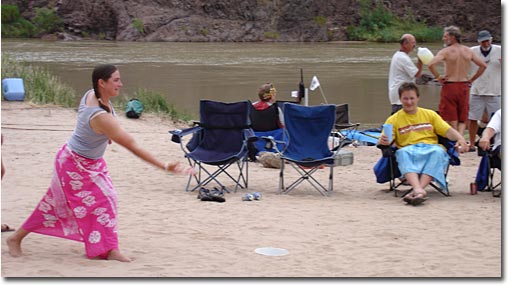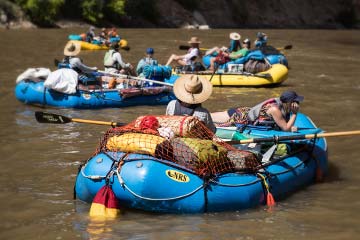A Fun Boating Game: Cans
Cans is a time honored river camp sport. According to Craig Lewis, in the Spring/Summer 1992 issue of the Palouse Journal, entitled “International Cans: The Laws, the History, the Future,” the sport was first played on an Idaho Selway River beach during a 1982 spring high-water float trip.
Some have called Cans a take-off on the game of horseshoes. Craig prefers to think of horseshoes as a stage in the development of the Game of Cans. I’ll let Craig and other devotees of the sport argue the finer points, here are the rules as I’ve seen them applied.
A Match
Played with two teams of two persons each. The number of points to a winning score has to be mutually agreed on. Typically a team must win by two points.
The Court
Any nice semi-level surface will do, preferably sandy. The targets were traditionally two round plastic bail buckets. In the modern era of cats and self-bailing rafts, the plastic bail bucket has become an endangered species. True aficionados of the sport will ensure that regulation buckets are part of the gear list. However, in the event of oversight, other receptacles can and have been substituted, including cut down plastic milk jugs and NRS Big Basins. Craig lists the distance between buckets as “13 River Paces, adjusted until it feels right.” Make the distance sporting, please. Place some rocks or sand in the buckets to keep them upright when struck with fully loaded cans.
The Cans
Each team plays with two 12-ounce aluminum cans. Some groups are fiercely opinionated on the brand of beverage that’s been consumed out of the cans but I will wisely stay out of that fray. Weight, in the form of sand, can be placed in the cans to facilitate throwing. Some choose to crush the can after the sand is introduced, simulating a hockey puck in appearance. Some choose to leave the can au natural, in its cylindrical symmetry. Warning: getting the sand out of a crushed can for recycling purposes is difficult and it’s unethical to submit it for paid recycling in the loaded state. Note: one must play with the same cans during a match, changing only between matches. Weighting can be adjusted at any time.
How Cans is Played
A member of each team plays from the opposing team’s buckets. Each “inning” consists of Team A’s member tossing both of their cans before Team B tosses theirs. Throws must be made with the leading foot not passing the near bucket. Starting order is mutually agreed upon. After an inning, the team that has scored points goes first in the next inning. If no points were scored, the team that had tossed second goes first.
How Cans is Scored
In an inning, only one team can score. A Bucket, where the can is wholly and totally within the bucket, is worth 3-points. A Leaner, where the can is touching the bucket, is worth 2-points. A Point, worth 1-point, is scored when a can is within a can’s distance from the bucket. In an inning, scores of equal value by the two teams cancel one another out.
Other Considerations
One fun way to play Cans is after dark. A candle or flashlight is placed in each bucket, emitting a warm glow. The candle option is the best since a Bucket usually snuffs it out! When using candles, put some sand in the bottom of the bucket to eliminate melt through!
Cans is a fun game, so play it in the Spirit of Fun. Players who take it so seriously as to go far beyond the Spirit may not get invited on the next trip!
Boat Safe, Play Often,
—Clyde

Photo by Blake Longworth.
 NRS Gift Card: Always Fits, Always Wanted
NRS Gift Card: Always Fits, Always Wanted




